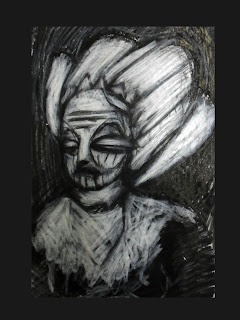Just a few notes... I'm going through a few trains of thought at present:
1. The religo-magical aspects of masks and the role of the wearer as 'human' and 'spiritualist' i.e.
transfigurement and secrecy of the mask2. Mask forms and meanings
3. Body modification in Primitive Cultures -
scarification and tatooing...
3. The role of the 'fetish' mask/statue in older civilizations
4. Orientalism and Contemporary artists who incorporate the mask into their work
The religo-magical aspect - Transfigurement and Secrecy of the Mask 
I'm reading a few books (
African Masks by Paul Hamlyn and
Secrecy - African Art that Conceals and Reveals by Nooter and
Spirits Speak - A Celebration of African Masks by Stepan a& Hahner) which all discuss how the mask 'transfigures' the wearer, as he relinquishes his own personality, and becomes the vehicle of superhuman spiritual power.
Nooter says in his book, "
Secrecy is central to all human affairs and artistic expressions: something is always revealed, something concealed. In African cultures, elaborate art works often announce the presence of secret knowledge while paradocixically protecting its contents..." I found this an incredible way to think about how mask 'transforms' its wearer... have a look at Leigh
Bowery's work - his masks really do conceal
an identitiy - but not necessarily his 'true' identity. With today's wearing of masks, the
individual nature of the person is embodied in the mask, rather than the communal or spiritual essence of some tribal ancestry. Debatable, certainly. So for me, the mask hasn't removed this mystical spiritual aura in modern day culture, we've just replaced the completely religious/spiritual or magical aspects with something else - more individual, less communal.
In old tribes, the spirit spoke through the masked dancer (very much a part of Nick Cave's
Soundmasks) and that the wearer became a 'sounding-board and mouthpiece' through which the spirit would communicate.
Mask forms and Meanings The mask had to inspire awe as well as satisfy the spirit as a worthy medium for its 'temporary habitation' and to demonstrate its authority to the onlookers... the elongated forehead in the mask, the multiple eyes, the use of certain colours and The mask shape, pattern, materials and scale usually came about through passed down craftsmanship and ceremonial knowledge...
Body modification in Primitive Cultures - Scarification and TatooingPatterns developed over time to signify cultural events. As with why we tattoo and 'brand' today, there was a connection to the tribal past which carried a strong cultural meaning, which was usually experienced as a 'rite of passage'. Much of scarification and tatooing was based on initiation ceremonies and as with the spiritual side, these were designed specifically for body art or masks... I find m

uch of the piercing, scarification and tatooing you find in tribal histories, a sort of 'bond' with why this sort of ritual is alive and thriving in many modern societies.

The
Fetish 
is an interesting one - in terms of tribal history, its an object which is believed to have supernatural powers (man made or natural). According to a few online sites, Fetishism is an attribution of inherent power of a given object or 'fetish'. Contemporary fetish (seen in Bowery's work, for example), is synonomous with works of eroticism and sexuality. The traditional use of the fetish was tied with everyday living,froma griculture to weather, social harmony or discord, health, fertility and progreation. Fetishes were typically modelled after an object of concern, such as a person, animal or body part. I am looking forward to investigating how this fits into the mask transformation.
Orientalism - having a look at previous influences of primitive masks in Western culture, brought be back to the nineteenth century 'primitive' art. As more European collecters returned with artifacts from Africa (and other ancient cultures, including Japanese), so the interest in native living and traditions. Artists Gaughin (1848 -1903), Matisse (1869-1954), Van Gogh (1853 - 1890) and then later Picasso, were all influencedby the African mask in some form or another....

Another contemporary artist I'm researching at the moment is
Zeng Fanzhi, who uses the mask to paint the state of modern man as "dark portraits of reality... [as] images of sickness, cruelty, pain and longing..." (artzinechina.com)...
 I have wanted to try two colour printing for a while, so I used this opportunity to experiment... The yellow ochre is actually acrylic paint, because I haven't got another oil based colour in the studio (yet!!). I would like to say tho', that I really enjoyed the results with the prints being inaccurate on the two colour print
I have wanted to try two colour printing for a while, so I used this opportunity to experiment... The yellow ochre is actually acrylic paint, because I haven't got another oil based colour in the studio (yet!!). I would like to say tho', that I really enjoyed the results with the prints being inaccurate on the two colour print


















































